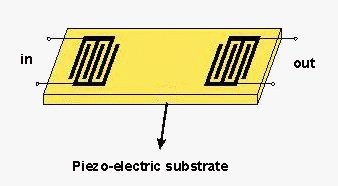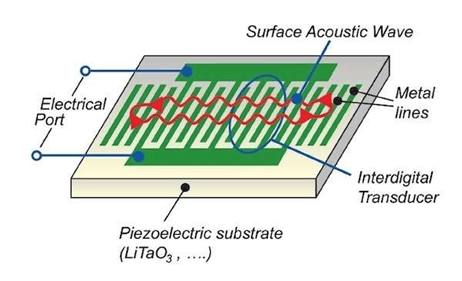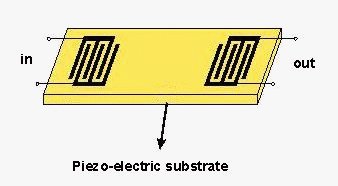What is Surface Acoustic Wave Filters?
SAW (surface acoustic wave) filters are a crucial part of contemporary electronic systems. It filters particular frequencies by taking advantage of the way acoustic waves travel across a material’s surface. The principle of piezoelectricity powers SAW filters. where a mechanical wave moving over the piezoelectric substrate’s surface is created from the electrical signal. After being transformed back into an electrical signal, this mechanical wave is filtered to remove undesirable frequencies. Digital sound waves (IDT), which are generated and detected by a transducer, are typically used in the construction of these filters.

Key Concepts and Components
Piezoelectric Substrate: Typically, piezoelectric materials like quartz, lithium niobate, or lithium tantalate are used to make SAW filters. The substrate’s ability to turn electrical impulses into mechanical (acoustic) waves—or vice versa—is made possible by its piezoelectric characteristics.
Interdigital Transducers (IDTs): A piezoelectric substrate surface-mounted comb-like device composed of metal electrodes. At the surface, IDTs are in charge of producing and receiving sound waves. Sound waves are produced when an electrical signal is applied to the IDT input by the surface moving across the substrate.
Reflection and Transmission: As sound waves travel along a substrate’s surface, they can be modified by transmission or reflection through various surface patterns. This enables the filter to pick out particular frequency components.
Frequency Response: Finger length and spacing are included in IDT design. It establishes the filter’s frequency response. SAW filters with specified pass and stop bands can be constructed by carefully adjusting these parameters.

How SAW Filters Work
Surface Acoustic Wave (SAW) filters function by employing a transducer to transform electrical signals into acoustic waves. arranged in a piezoelectric surface interlacing (IDT). These waves travel along the substrate’s surface, selectively filtering specific frequencies. The filtered waves are then converted back into electrical signals, providing precise frequency control.
Types of SAW Filters
Resonator-based SAW Filters
An IDT and a periodic reflector combine to generate the resonant structure used by the resonator-based SAW filter. The piezoelectric surface develops a resonance channel as a result. This attenuates certain frequencies and increases others. This produces a filter that is extremely selective. appropriate for uses where great frequency selectivity is needed.
Delay Line-based SAW Filters
Delay line-based SAW filters use the propagation delay of acoustic waves between input and output IDTs to achieve filtering. The spacing and orientation of the IDTs determine the delay, filtering out specific frequencies. These filters are suitable for applications needing phase linearity and wide bandwidth.
Materials and Fabrication Processes
Piezoelectric materials including quartz, lithium niobate, and lithium tantalate are commonly used in the manufacturing of SAW filters. The speed and attenuation of sound waves are influenced by substrate materials, and this in turn influences the filter’s efficiency. Optical lithography is used to precisely print the IDT on the substrate. This guarantees precise and consistent filter properties.
Key Applications of SAW Filters
Telecommunications
SAW filters play a critical role in the communications industry. In mobile phones, it enables effective signal processing for crystal-clear voice communication and data reception. By removing undesirable frequencies, they also increase the effectiveness of wireless communication systems. enhanced dependability and quality of the signal.
- Mobile Phones
SAW filters in mobile phones help isolate specific frequency bands, reducing interference and enhancing signal clarity. They enable multi-band operation, allowing phones to support various network standards and frequencies worldwide.
- Wireless Communication Systems
SAW filters are crucial for pre-transmission and pre-reception signal filtering in wireless communication systems. maximize the use of frequency, lower noise levels, and enhance system performance overall. This helps ensure a dependable wireless connection.
Consumer Electronics
SAW filters are integral to various consumer electronics, ensuring optimized performance in signal processing and communication.
- TVs and Radios
In TVs and radios, SAW filters improve signal reception by selectively filtering frequencies, reducing noise and improving audio and video quality.
- Gaming Consoles
SAW filters in gaming consoles enhance wireless communication capabilities, ensuring seamless connectivity for multiplayer gaming and online interactions.
Medical Devices
SAW filters are employed in medical devices to enhance signal processing and communication reliability, crucial for diagnostic accuracy and patient monitoring.
- Diagnostic Equipment
In diagnostic equipment, SAW filters filter signals to ensure precise data collection and analysis, contributing to accurate medical diagnostics.
- Wearable Health Monitors
SAW filters in wearable health monitors filter physiological signals, enabling continuous and reliable monitoring of vital signs for better healthcare management.
Emerging Applications in Advanced Technologies
Internet of Things (IoT)
SAW filters are a crucial component of Internet of Things applications, enabling robust data processing and communication capabilities in diverse settings.
- Smart Home Devices
In smart home devices, SAW filters ensure reliable wireless connectivity and efficient signal management, enhancing device interaction and user experience.
- Industrial IoT Applications
SAW filters enhance industrial IoT by streamlining communication and sensor networks. facilitating efficient operations and real-time data transfer in industrial and manufacturing settings.
Automotive Industry
In automotive applications, SAW filters are crucial for maximizing performance and connection. This enhances the characteristics that are safe and entertaining.
- Advanced Driver-Assistance Systems (ADAS)
Accurate processing and filtering of sensor data is made possible by SAW filters in ADAS. Improving vehicle safety and making judgments in real time depend on this.
- In-Vehicle Infotainment Systems
SAW filters enhance the dependability and clarity of signals in infotainment systems. They offer a smooth connection for in-car communication and multimedia streaming.
Defense and Aerospace
SAW filters play a significant role in aerospace and defense applications. They assist with navigation and communications systems that are vital to missions.
- Communication Systems
In defense communication systems, SAW filters optimize signal transmission and reception, ensuring secure and reliable communication in challenging environments.
- Radar and Navigation Systems
SAW filters precisely filter signals, enhancing navigation and radar systems. This makes it possible for defense and aerospace operations to navigate and detect targets accurately.
Advantages
– High-Frequency Operation: Able to function at few MHz to many GHz frequencies.
– Compact Size: Compact and light-weight. making it appropriate for handheld gadgets.
– High Selectivity: Can achieve sharp filtering characteristics, which is essential for communication systems to avoid interference.
Disadvantages
– Temperature Sensitivity: Performance can be affected by temperature changes, though materials like quartz are used to mitigate this effect.
– Power Handling: Generally, they have lower power handling capabilities compared to other types of filters like ceramic or cavity filters.
In summary, SAW filters play a crucial role in modern electronic systems by providing high-frequency filtering with precision and reliability.
